Types of Ants With Identification and Pictures (Identification Chart)
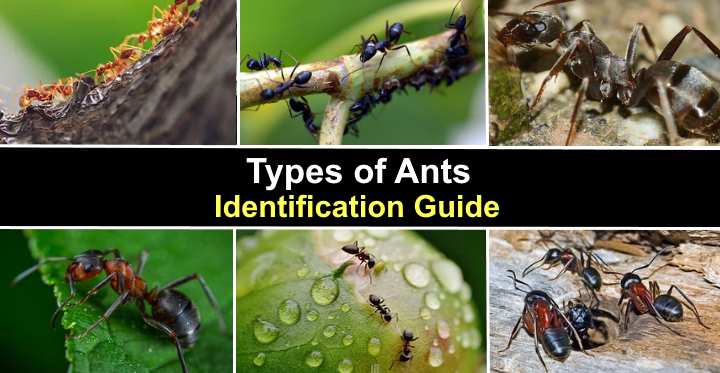
Ants are a type of small insect with three distinct body parts, six legs, and two antennae. Black ants are the most common type; however, ant species can also be dark brown, tan, or red colors. Some types of swarming ants also develop wings. But most ants are tiny creepy crawlies that get around by walking.
Small ants and large ants are social insects that live in large colonies. Therefore, if you spot a few ants in your home or garden, the chances are that there are hundreds of ants nearby. Ants can become a nuisance pest in homes or gardens. These tiny bugs can inflict painful stings and chew through wood, electrical cables, or insulation.
This article is a comprehensive guide to identifying common types of ants you’re likely to encounter at home or in the yard. Knowing how to identify an ant species can help you understand how to get rid of the tiny crawling insects.
How to Identify Ants
Ant identification is by their color, size, and body shape. Ants have three pairs of legs and three identifiable body parts — the head, thorax, and abdomen. Some ants have large, bulbous heads and abdomens with a thin thorax. The common names of some ants describe their appearance and habits.
For example, small odorous ants, black household ants, little black ants, crazy ants, and white-footed ants are types of ants where their common names help identify their characteristics.
Types of Ants With Pictures and Names — Identification Guide
Let’s look in detail at the identifying features of common types of ants.
Pharaoh Ant (Monomorium pharaonis)
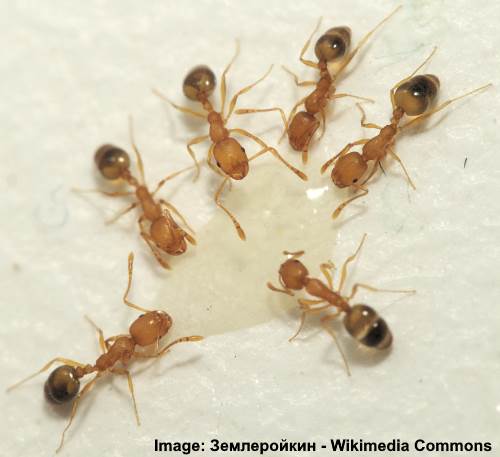
A close up picture of the miniature tiny Pharaoh ant
The pharaoh ant is a small light brown or orange-yellow ant that can become a significant pest in buildings. The tropical ant measures around 0.078” (2 mm) long. The tiny brown ant has a large dark brown to black bulbous abdomen and two distinctive club antennae.
Pharaoh ants live in large colonies and have several red-colored queen ants per colony. The ants feed on sugary and greasy foods and can infest wall voids, furniture, and under floors.
It is said that an ant bait consisting of 1 percent boric acid and sugary water can kill pharaoh ants.
Ant Identification
Pharaoh ants have slender, light brown, almost translucent bodies with a large ball-like blackish abdomen.
Small Odorous House Ant (Tapinoma sessile)
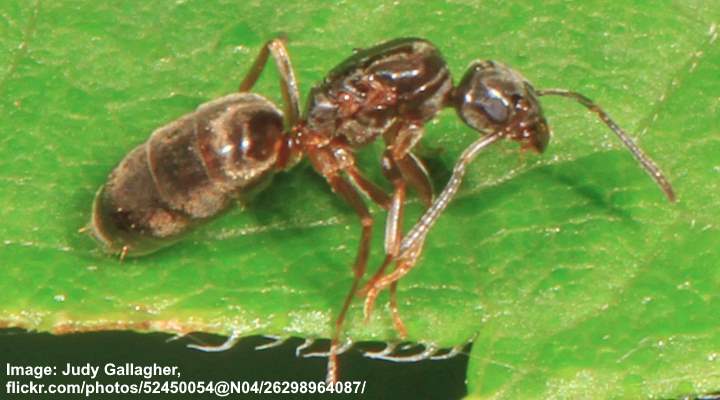
Enlarged picture of the small odorous house ant that emits foul smell when crushed
The small odorous house ant is black or brown and measures between 0.06” and 0.12” (1.5 – 3.2 mm). The tiny ants are recognized by their abdomen (gaster) that is closely joined to the thorax. This feature makes the abdomen appear pointed downward.
Odorous house ants typically feed on honeydew — a common sign of aphids on houseplants or garden shrubs. The best way to prevent odorous ants from infesting homes is to keep vegetation and plants growing away from buildings.
The small odorous house ants got their common name because of the nasty smell they emit when crushed. These small black ants are also called the stink ant for the same reason.
Ant Identification
The brown odorous house ant is identified by its oval abdomen, triangular head, and segmented antennae.
Black Household Ant (Ochetellus glaber)
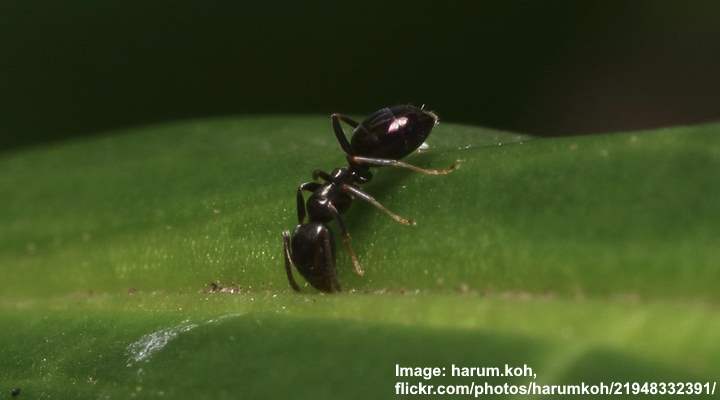
The small black household ant can also be dark brown, depending on the species
The tiny black household ant can be jet black or dark brown, depending on the subspecies. Black house ants measure 0.08” to 0.11” (2 – 3 mm) long. The ants have curved antennae, and their legs may appear yellow. Up close, pictures of the black ants show they have a wrinkled face and large compound eyes.
The tiny black or brown household ants feed on sweet liquids and you’ll often find these common household invaders in the bathroom, kitchen, or laundry room. Outdoors, the ants feed on honeydew, nectar, and other insects. The black ants are common in Florida and other states in the southern US.
Ant Identification
The black household ant is a tiny ant that can be brownish-black or dark brown in color with a narrow waist, slender thorax, and large abdomen.
Little Black Ant (Monomorium minimum)
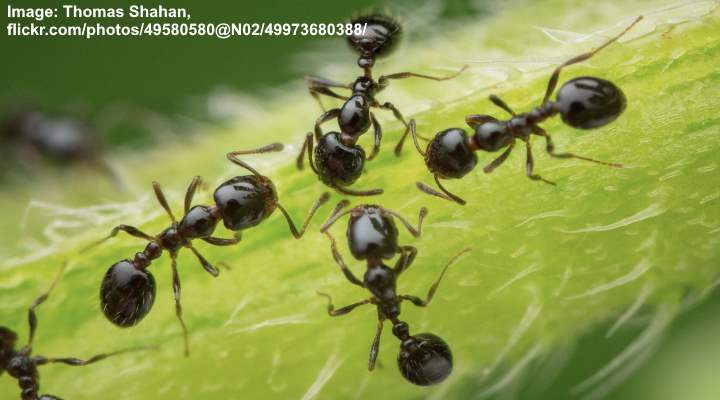
The little black ants are common in dark places in the house and garden
The little black ant is a type of little jet-black ant measuring 0.04” to 0.078” (1 – 2 mm) long. The tiny black ant is recognized by its two-segmented waist (pedicel), clubbed antennae, stinger, and ball-like, shiny black abdomen. The tiny black ants live in medium-sized colonies.
Little black ants are found throughout the United States, especially in California. The small black ants inhabit dark places in yards under logs and piles of bricks. You’ll find the little black ants inside homes in wall voids, behind baseboards, or in masonry crevices.
Ant Identification
Little black ants are identified by their shiny black bodies, club antennae, and tiny size.
Black Carpenter Ant (Camponotus pennsylvanicus)
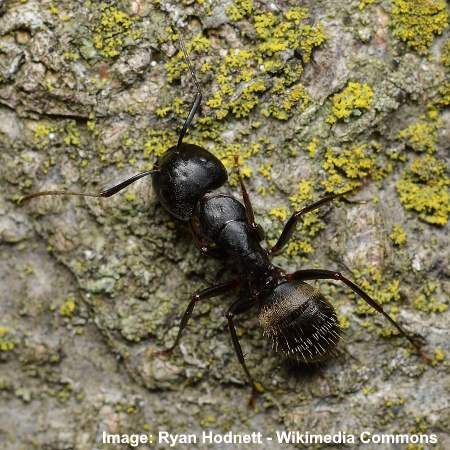
The big black carpenter ant can damage wooden furniture and structures
Carpenter ants are some of the largest black ants, measuring 0.23” to 0.5” (6 – 13 mm) long. The large black ants have whitish hairs on their bodies and a striped abdomen. Additionally, the ants have characteristic elbowed antennae and six brownish-black legs attached to the thorax.
Carpenter ants get their name from their habit of excavating dead wood. Unfortunately, this means that the destructive black bugs can damage furniture and even cause structural damage over time. To prevent a carpenter ant invasion, reduce humidity and keep moist wood away from structures.
Ant Identification
The black carpenter ant is a large ant with a dull black body, fuzzy abdomen, and smooth thorax.
Pavement Ant (Tetramorium)
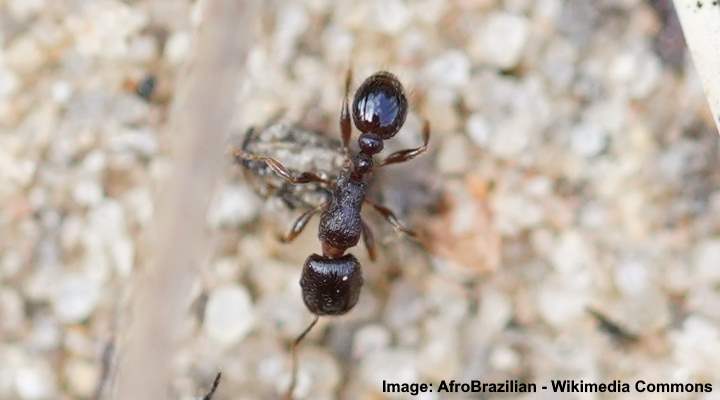
Pavement ants include many species. In the picture: Tetramorium caespitum
The pavement ant is a common dark brown ant that can sting humans. The slender brown ant has a rounded head, oval brown abdomen, and stinger. These small brown insects measure 0.1” (3 mm) long and are difficult to spot due to their minuscule size.
Pavement ants thrive in sand and soil and prefer to live under sidewalks, driveways, and patios. Inside homes, you may find pavement ant nests in basements. Unfortunately, the ants tend to nest underground, making getting rid of the brown bugs challenging.
Ant Identification
A pavement ant is recognized by its dark brown to black body with recognizable ridges and fine hairs on its head and thorax. Pictures of the brown ant show it has a stinger at its tail end.
Black Garden Ant (Lasius niger)
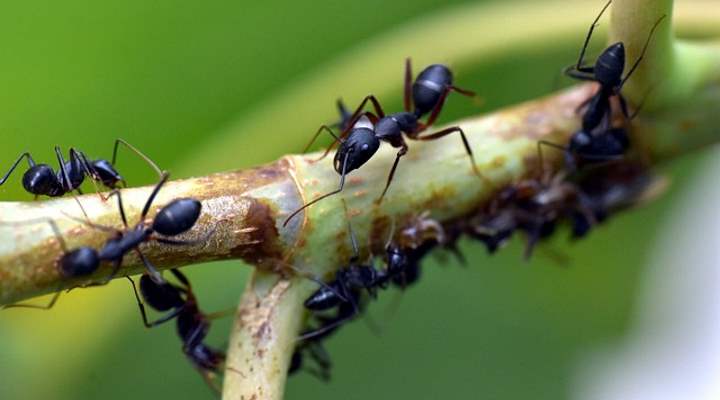
The small black garden ant is common in many parts of the world
Called the common black ant, this small black insect measures around 0.2” (5 mm) long. Sometimes a dark brown color, the common garden ant has identifiable erect hairs on its antennae and top leg sections. In addition, some black ants have a faint stripe around their abdomens and a thin waist.
The black garden ant is the species you are likely to find in your yard. The male flying ants can sometimes find their way into homes. This can attract hordes of more ants to come foraging for sweet foods.
Ant Identification
The common black garden ant has a recognizable black, bulbous abdomen attached to the thorax by a thin waist and six dark brown legs.
Related reading: How to Control Ants in the Garden
Banded Sugar Ant (Camponotus consobrinus)
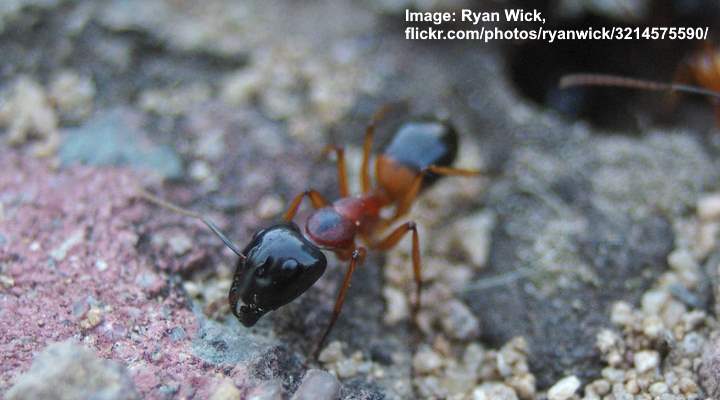
The orange-brown and black banded sugar ant is relatively large and is found in forests and houses
The banded sugar ant is dark brown to black and has a light-colored rusty brown band around its abdomen. Measuring 0.2” to 0.6” (4 – 16 mm), the large brown ant has a shiny black triangular head, egg-shaped brown and black abdomen, and coppery-brown legs.
The banded sugar ant is native to Australia. You will also find colonies of sugar ants nesting under shrubs, dead wood, and in the soil. The black and orange-brown ants also construct nest mounds above ground.
Ant Identification
A banded sugar ant appears to have a rusty brown band on its black abdomen. The orange-brown ant has a black head and brown legs.
Yellow Meadow Ant (Lasius flavus)
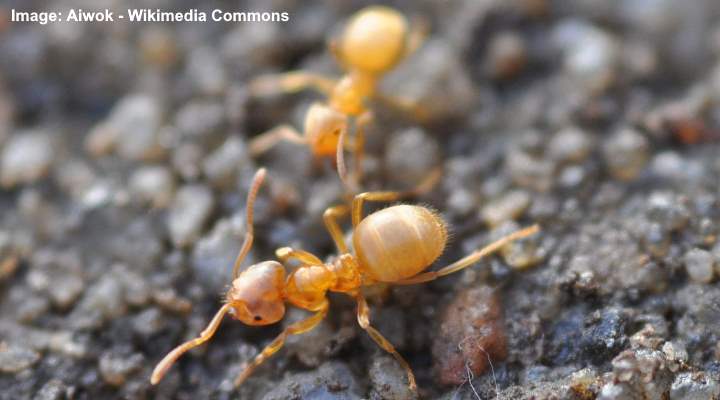
The little yellow meadow ant feeds on aphids honeydew
The yellow meadow ant is a common small yellowish-brown ant species, measuring 0.78” to 0.15” (2 – 4 mm) in length. The meadow ant has a yellow head, thorax, and abdomen (gaster), which is darker at the edges. The antennae are 12-segmented and end in a three-segmented club.
The yellow meadow ants are not particularly aggressive and often nest under rocks or slabs. These tiny yellowish-brown ants also protect aphids as they like to feed on the honeydew. You may find them in gardens when they create a soil dome for a nest.
Ant Identification
The yellow meadow ant has an identifiable yellowy-brown color and an egg-shaped yellowish abdomen with fine setae (hairs) at its tail end.
Fire Ant (Solenopsis spp.)
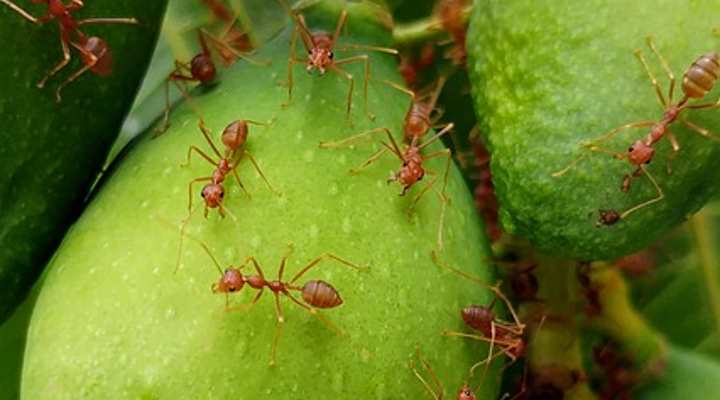
The fire ant is a small red ant that can cause a painful sting
The fire ant is a common stinging slender ant identified by its dark brown to red color and aggressive behavior. The nasty small red ants have a copper-brown head and thorax and dark red abdomen. Additionally, they have two ten-segmented antennae with two-segmented clubs. The small red ants measure 0.8” to 0.23” (2 – 6 mm).
Fire ants can be found in Texas, Alabama, and other states in the southern US. The tiny fire ants are known for their painful stings that cause pain, like being burned by fire. Red fire ants nest in the soil or dome-shaped mounds and can attack when disturbed.
Ant Identification
The small red fire ant is easily identified by its reddish-brown color, two black eyes, exceptionally slender thorax, and large reddish-brown abdomen.
Crazy Ant (Paratrechina)
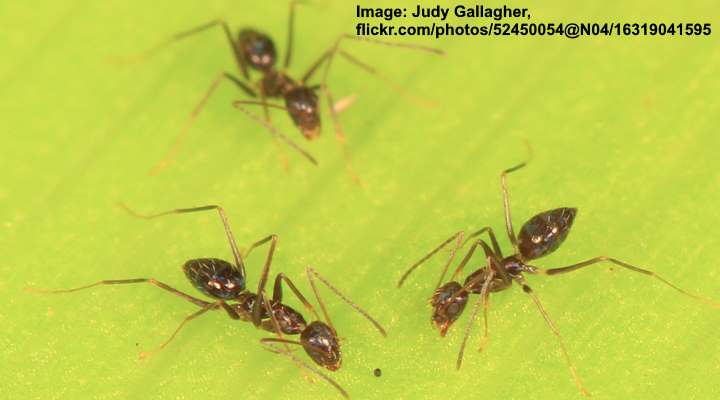
A magnified photo of the long legged crazy ant (Paratrechina longicornis)
The crazy ant is a species of small dark brown to black ant with whitish setae and extremely long antennae. These tiny, fast-moving ants measure 0.9” to 0.11” (2.3 – 3 mm) and have an unevenly rounded thorax. Small crazy ants are known for their erratic, speedy movements.
Crazy ants are a species of tropical ant commonly found outdoors in Florida and the Gulf states. However, the reddish-brown crazy ants also live in the house in temperate climates. As a result, they are a serious nuisance pest and forage on household foods, fruit, plant honeydew, and seeds in many areas.
These crazy ants can be extremely difficult to get rid of.
Ant Identification
A crazy ant is distinguished from other ants by a long pair of antennae, brownish-black color, and thin legs with relatively few hairs on them.
Ghost Ant (Tapinoma melanocephalum)
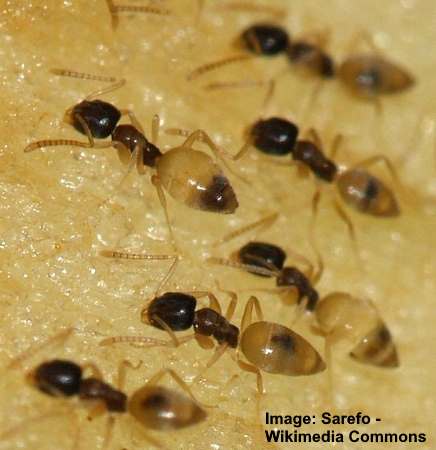
The tiny ghost ant is identified by its dark brown head and beige translucent abdomen
The ghost ant is a species of tiny dark brown and creamy white ant common in Florida. The ghost ant is identified by its dark brown head and thorax, pale translucent abdomen with faint dark patterns. These difficult-to-spot tiny ants measure 0.05” to 0.08” (1.3 – 2 mm) long.
Ghost ants are a common household pest in Florida, Texas, and throughout the US. Ghost ants are common household invaders and they can be found in kitchens, bathrooms, and other humid areas. They typically nest outdoors but will forage indoors if conditions are suitable and moisture is present.
Ant Identification
A ghost ant is identified as a small brown ant with a yellowish abdomen, milky white antennae without clubs, and six transparent legs.
Red Wood Ant (Formica rufa)
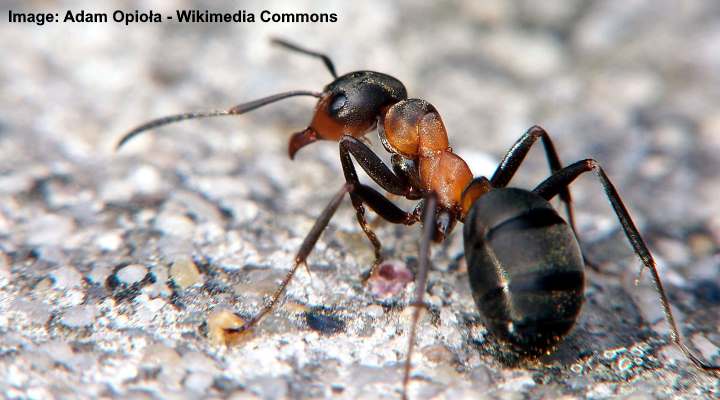
The red wood ant has a black abdomen and creates large nests in the forests
The red wood ant is identified by a black abdomen and red thorax, black and red head, and long black legs. This type of small black and red ant species measures 0.17” to 0.35” (4.5 – 9 mm). The red ants have short, elbowed antennae.
Also called thatching ants, wood ants, mound ants, and field ants, the ants are found in deciduous forests throughout the United States. The small ants create large ant hills, sometimes several feet high. The busy ants typically feed on aphids and are important in forestry management.
Ant Identification
The small red wood ant is identified by a reddish-brown head and thorax, a dark brown or black abdomen, and black legs. The red ants are easy to spot in forests because they appear in large numbers.
Argentine Ant (Linepithema humile)
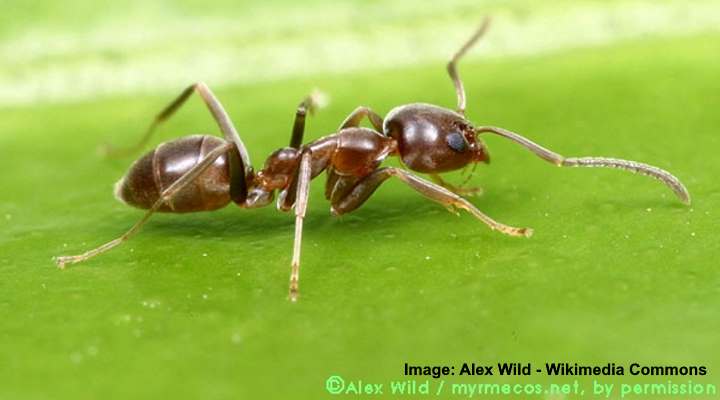
The brown Argentine ant can be a serious household pest
The Argentine ant is a tiny, brownish-colored ant measuring 0.06” to 0.11” (1.6 – 2.8 mm) long. The light to dark brown ant has a distinguishable single node between the abdomen and thorax and two bands over the abdomen. Another feature of the Argentine ant is its tan legs and segmented antennae.
Argentine ants are an invasive species and a significant pest in urban areas. The pesky insects invade homes during dry or hot weather and forage for food in kitchens. There can sometimes be hundreds of these brown ants scurrying over floors.
Ant Identification
Argentine ants are small, light to dark brown ants with pale brown legs and club-less antennae with 12 segments.
Leafcutter Ants
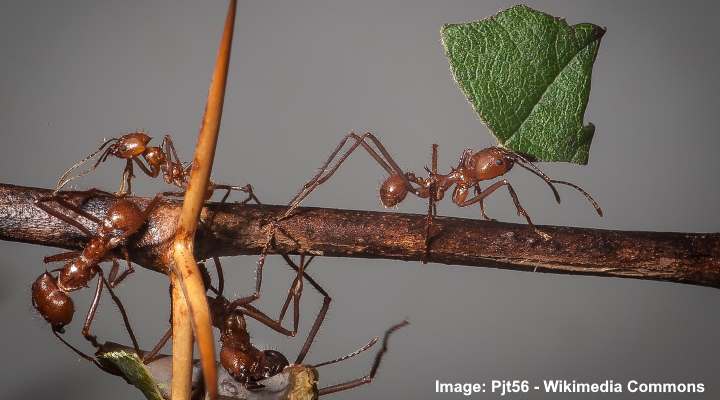
Leafcutter ants can be found in South and Central America, and southern USA
Leafcutter ants comprise of over 40 ant species that cut leaves with their mandibles (mouthparts) to carry them back to the nest. The common identifying feature of leaf-chewing ants is how hundreds of the insects carry leaf parts in line, one after the other.
In some places, leafcutter ants can be serious agricultural pests. For example, some species can strip citrus trees bare in less than 24 hours.
The species Atta sexdens, is a type of red ant with a broad, rounded head, slender thorax, and small, round abdomen. The red ant measures around 0.04” to 0.08” (1 – 2 mm) long. The largest of the red leafcutter ants can have a head over 0.11” (3 mm) wide.
Red Harvester Ant (Pogonomyrmex barbatus)
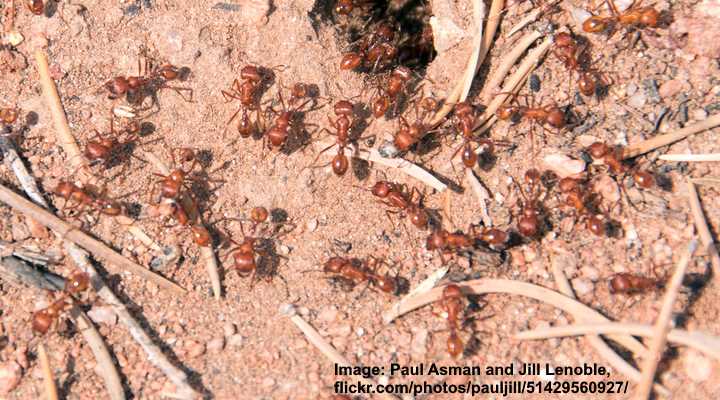
The red harvester ant has copper-brown body and are often confused with fire ants
The red harvester ant has a large, red to brownish body with a rounded, bulbous abdomen and elongated thorax. These copper-brown large ants measure 0.19” to 0.27” (5 – 7 mm) long. Identifying features of the harvester ants are fine setae on its back and abdomen, small black eyes, and red elbowed antennae.
Because of their red appearance, red harvester ants are easy to mistake for unrelated fire ants. Species of harvester ants are common in Texas and other states throughout the US and Canada. Although these are red stinging ants, they rarely sting.
Ant Identification
The red harvester ant is a large reddish-brown ant with two 12-segmented antennae and fine hairs on its head. The red ants are easy to spot in a landscape because they construct large, mounded nests.
White-Footed Ant (Technomyrmex albipes)
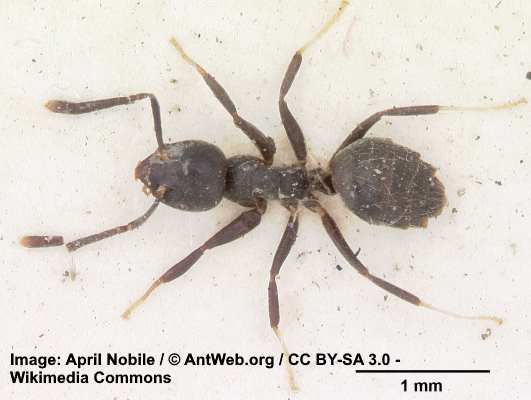
The small white-footed ant can be found in forests as well as homes
The white-footed ant is a small black ant with six black legs and creamy-white tips. Typically, the dull black ants measure 0.08” to 0.16” (2 to 4 mm) long. Identifying features of the white-footed ants are two 12-segmented antennae, five abdominal segments, and fine setae on its back.
White-footed ants look like Argentine ants and are often confused with crazy ants. The black and white ant is common throughout Florida, Louisiana, Georgia, and South Carolina. It is considered a pest when it infests indoor spaces.
Ant Identification
The white-footed ant has identifiable white legs and a black head, thin thorax, and egg-shaped brownish-black abdomen.
Pyramid Ant (Dorymyrmex bureni)
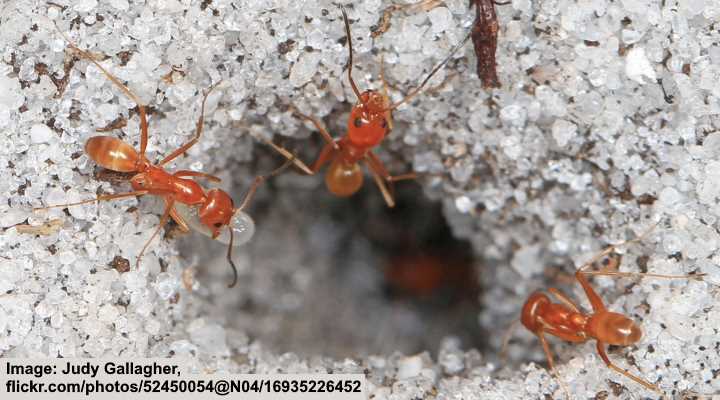
The pyramid ant has orange-reddish body and emit bad odor when crushed
The pyramid ant is medium-sized with a pale orangey-red or pale-yellow body, club-less antennae, no sting, and a slender body. The ant is not considered aggressive. However, it emits a foul stench of rotten coconuts when crushed. The small to medium-size ants measure 0.8” – 0.16” (2 – 4 mm) long.
Common to Florida, the pyramid ant is not classified as an aggressive ant, unlike red fire ants. Instead, the small reddish-brown ants with their tiny black eyes feed on honeydew, other insects, and live outdoors in nests they construct in mounds of sand.
Ant Identification
The pyramid ant is a slender orange-red ant with six thin orange legs, long 12-segmented antennae without a defined club, and a pyramid-shaped projection on the thorax.
Learn How to Control Ants in the Garden.
Related articles:
